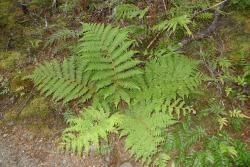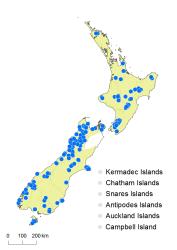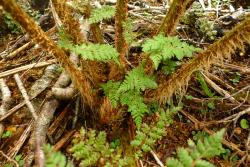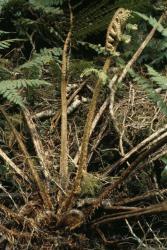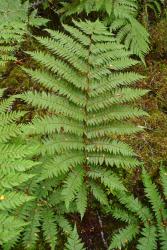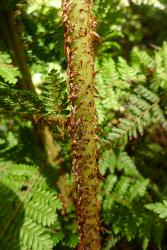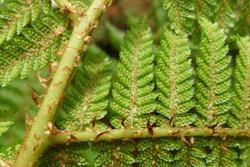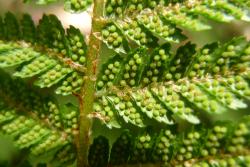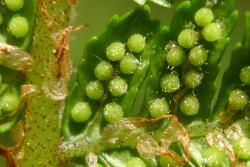- ≡ Alsophila colensoi Hook.f., Bot. Antarct. Voy. II (Fl. Nov.-Zel.) Part II, 8, t. 73 (1854)
Rhizomes prostrate, ascending at apex, very rarely forming a short woody trunk up to 1 m tall and 80 mm diameter, covered in stipe bases; bearing scales near the apex. Rhizome scales marginate, acicular, lacking dark-coloured setae, very pale brown. Fronds 460–1500 mm long, held upright; dead fronds falling. Stipes 90–700 mm long, 4–20 mm wide, 4–5 mm deep, red-brown proximally, often yellow-brown distally, finely tuberculate or smooth, bearing hairs and scales; hairs fine, acicular, colourless or pale brown, up to 1 mm long; scales acicular, pale brown or with pale margins and dark centres, lacking dark-coloured setae, densely covering base of stipe, up to 40 mm long and 3 mm wide, becoming more scattered distally, interspersed with dense red acaroid scales c. 0.1 mm in diameter. Laminae deeply 2-pinnate-pinnatifid to 2-pinnate-pinnatisect, elliptic or ovate to broadly ovate, 370–1150 mm long, 190–740 mm wide, dark green on both surfaces, herbaceous; adaxial surfaces of rachis, pinna midribs, costae and laminae abundantly covered in fine, acicular, colourless or pale brown hairs up to 1 mm long; abaxial surfaces bearing pale scales with bullate or flattened bases and attenuate apices, up to 2 mm long and 0.5 mm wide, and red acaroid scales c. 0.1 mm in diameter, occasionally with a small flattened pale brown base; rachis red-brown or yellow-brown, becoming yellow-brown distally, smooth or finely tuberculate. Primary pinnae in 20–25 pairs, narrowly ovate or narrowly triangular; the longest at or below the middle, 130–400 mm long, 45–120 mm wide, short-stalked. Secondary pinnae narrowly ovate or narrowly triangular, the longest 23–65 mm long, 7–15 mm wide, short-stalked or sessile. Longest tertiary segments 3–7 mm long, 1.5–2.5 mm wide, adnate; apices acute; margins entire to crenate. Sori 0.5–0.8 mm in diameter; paraphyses longer than sporangia; indusia absent.
Cyathea colensoi is the only species of the genus in New Zealand that produces fertile fronds from a prostrate rhizome. Very rarely plants with a short trunk no more than 1 m high have been observed but these cases are exceptional. Cyathea colensoi is also the only native species that lacks an indusium. It has conspicuous hairs in the sorus which are longer than the sporangia. It is often mistaken in the field for young plants of C. smithii, but the latter species never produces fertile fronds until it has developed a trunk.
North Island: Northland, Auckland, Volcanic Plateau, Gisborne, Taranaki, Southern North Island.
South Island: Western Nelson, Sounds-Nelson, Westland, Canterbury, Otago, Southland, Fiordland.
Stewart Island.
Altitudinal range: 60–1150 m.
Cyathea colensoi is a fern of montane forest in the North Island, occurring from Table Mountain, Te Aroha, Mt Pirongia and the Honokāwā Range south through the Urewera Ranges, Volcanic Plateau, Mt Taranaki, Ruahine and Tararua Ranges, occupying a zone from c. 400 m to 1100 m. However, there are early collections by Harry Carse from Mt Maungataniwha and from Tākou, Whangaroa by H.B. Matthews which are well north of the currently known distribution. The presence of C. colensoi in Northland needs confirmation. In the South Island C. colensoi is widely distributed as a fern of montane forest, reaching 1150 m on Mt Owen, but descending to 60 m at the Pororari River, Westland and to 80 m in coastal regions of north-west Nelson. It is absent from Marlborough and much of inland Otago.
Cyathea colensoi occurs most frequently under beech forest, but also under podocarp, Weinmannia, Metrosideros umbellata and Libocedrus forest, and occasionally on road cuttings or under scrub.
n = 69 (Brownlie 1958).
There are two collections in the Hookers’ Herbarium at K, numbered 1673 and 1673α. Colenso’s collections were sent to W.J. Hooker in a letter dated 21 January 1848. In the letter, Colenso stated "1673. Polypodium ruahinensis, W.C., a beautiful species - never arborescent, fronds 4–5 feet long, woods, ascent to Ruahine, ½-way up. It has hairs under its sori, and had it been arborescent, I should have called it an Alsophila". The specimens themselves are labelled "Polypodium ruahinense" (St George 2009). Colenso 1673 was chosen as the lectotype by Brownsey & Perrie (2015).



